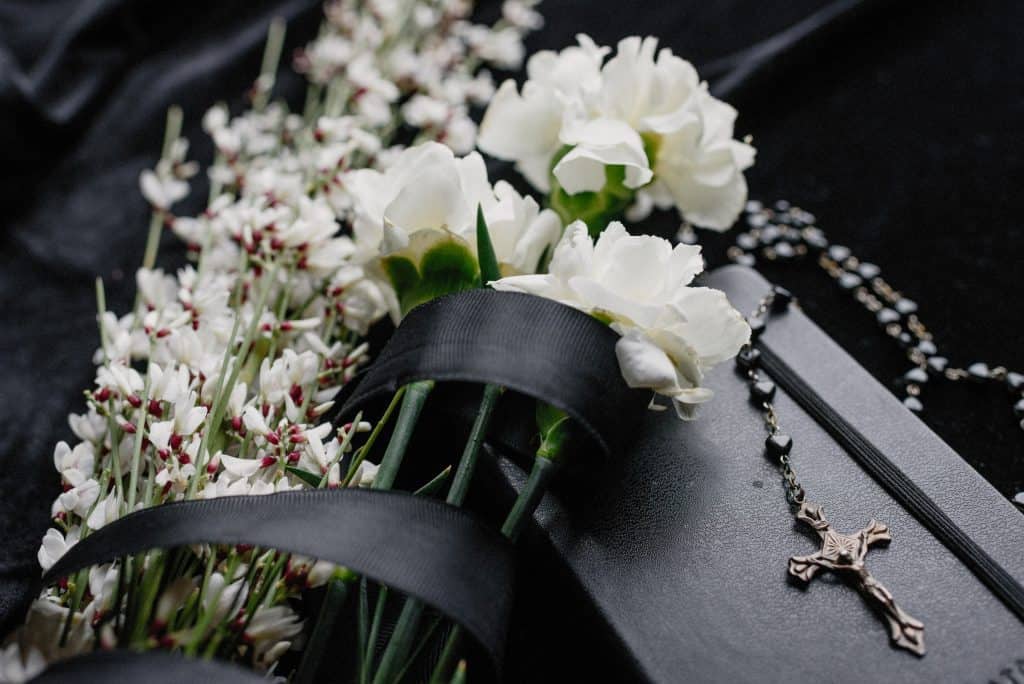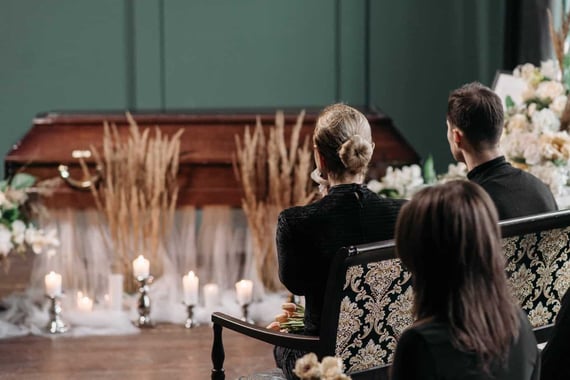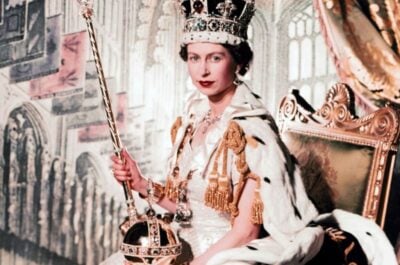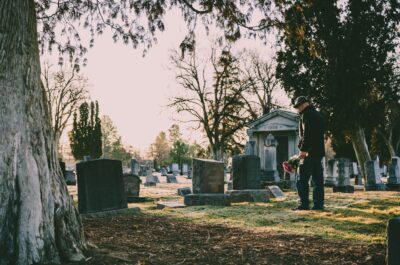Amidst the staggering grief of death, you can get quickly overwhelmed by all the administrative details of death, funeral planning, and burials. We want to help you navigate the multistep process of planning a funeral ceremony so that you can honor the deceased and create a nurturing environment for each funeral celebrant to remember their loved ones.

How to Plan a Funeral Ceremony
1. Review the Wishes of the Deceased
The first place to start is with any documented or remembered wishes of the deceased. Many individuals have taken the time to document their wishes for their passing. This might include a Do Not Resuscitate (DNR), power of attorney, executor of their estates, a last will and testament, or even an entire funeral ceremony or program outline.
Check with the surviving spouse, next of kin, or the deceased’s legal representative for any documented wishes regarding their death and burial. If they recorded that they wished to be cremated without a formal funeral arrangement or cremation ceremony, you may have very short work on your hands.
If no formal documentation exists for their funeral ceremony, burial request, or other relevant details, you may need to turn to those closest to the deceased or use your best judgment. It’s possible that your father never explicitly wrote it down, but he was often heard saying “I don’t want a funeral service—just a quiet burial.” These types of observations may guide you as you plan a funeral ceremony.
2. Outline Your Finances
Life insurance or funeral insurance creates certain provisions for funeral ceremonies and burials. Now is the time to figure out if your loved one had life insurance, prepaid funeral services, or dedicated savings that can be used for funeral expenses. You might consider calling various funeral homes and venues to determine what you may need to pay for the funeral and burial services, as the funeral cost may be high.
Many religious venues, like a church, host traditional funeral ceremonies for free or at a low cost. Funeral homes may also host funeral ceremonies as part of their burial packages. Similarly, if you need a clergyman or officiant, most will conduct a funeral ceremony free of charge but will need to be scheduled in advance.
3. Begin the Funeral Process
The disposition process for the deceased includes being claimed by a funeral home, embalmed, dressed, and prepared for final resting. There are several important decisions that will need to be made that may not directly affect the funeral ceremony, but nonetheless need to be managed before moving forward.
The burial process might involve choosing a casket (or urn for cremation), a burial plot in a cemetery, notifying insurance and employers, writing and submitting an obituary, selecting a headstone, and obtaining a death certificate.
4. Determine the Components of Your Funeral Ceremony
Now it’s time to start creating a funeral ceremony or memorial that will honor your loved one, and create an environment for love and closure. What do you actually want the funeral ceremony to be like? What would best honor the deceased?
Here are a few things to consider:
- Location of ceremony
- Length of ceremony
- Religious elements, such as prayers, scripture readings, grave dedications, etc.
- Familial remembrances, such as a eulogy or telling stories about the deceased
- Obituary or life story recitation
- Hymns and/or musical numbers
- Poetry or other readings
- Viewings or wakes before the ceremony
- Number of guests and how invitations will be extended
- Programs—digital or printed?
- Pallbearer assignments
Follow the documented wishes of the deceased as far as possible, then turn to the immediate family and friends to make the remaining choices. You’ll have to take direction from the circumstances, such as the venue, weather, timing, and budget.
You don’t need to take full responsibility for the entire funeral ceremony yourself, though. Delegate different parts of the ceremony to other involved family members. For example, you might ask the spouse to choose their favorite hymns, the children to perform the speaking portions of the ceremony, and a close friend to coordinate the clergy.
Once you’ve made decisions or extended assignments, be sure to write it down and follow up in the days leading to the funeral. Unfortunately, hiccups do happen—even at this most inopportune time—so having a backup is helpful.
5. Create Funeral Ceremony Ambiance

One of the best ways to honor the deceased is to have the funeral ceremony reflect their unique characteristics. For example, wearing all black to the funeral of a vibrant and colorful person feels inauthentic. Make choices about the aesthetics of the funeral ceremony which will help everyone feel closer to the deceased and work through their grief with some sense of closure.
If you’d like to display flowers, order some arrangements that feel comforting and look beautiful. Donations in lieu of flowers are common—just be sure you’re clearly communicating that option. A large memorial portrait or poster is a sweet way to welcome mourners into the funeral ceremony. Create a playlist for before and after the memorial service, and carefully curate the musical numbers that will be used during the service.
A memorial slideshow of images or videos can be a meaningful way to remember the full life of your loved one and can be played on a large screen during the service or looped on a smaller monitor as guests enter the venue.
In the COVID era, many funerals turned to technology when in-person attendance was limited. Now that gathering restrictions are loosening, virtual memorials are still continuing, as they allow people to remain connected even when distance or illness makes it difficult to attend. If you plan to stream the funeral ceremony, we recommend testing your technology beforehand and delegating the streaming task to someone uninvolved in the memorial.
6. Organize Post-Funeral Arrangements
If you are hosting a funeral ceremony at a place other than the burial site, you’ll need to arrange transportation (i.e. a hearse) to the burial site. If you plan to have a graveside service, you might need a canopy, seating, a sound system, or other items to ensure a comfortable and accessible graveside service. Similarly, cremated remains may be buried or scattered as part of the funeral program.
Following a burial or graveside service, it’s common to have a luncheon following the funeral. Some families may choose catering, if it’s in the budget, or if it’s included with the funeral home package. A potluck where attendees bring dishes to share, or the community provides the meal, is a cost-effective option and allows people to serve and connect in a time of need.
7. Create Your Funeral Program
Once you have a good idea of your funeral ceremony, you can craft the program. A good funeral ceremony program should feature the name, photo, birth and death dates, and possibly the obituary of the deceased individual on its front and inside covers. The program should outline the order of events in the ceremony, as well as the names of those performing each element. Include any relevant information, such as the address of the gravesite service and luncheon, and where they can send donations in lieu of flowers.
We also love to include a QR code with a link to an online memorial site or digital guest book, or perhaps a direct link to their preferred charity or GoFundMe.
8. Test Run Your Funeral Ceremony
We recommend working closely with a funeral director as you build out your own personalized funeral ceremony—they have the experience to make things much easier for you. When you think you have your funeral ceremony adequately planned, it’s time for a test run.
You don’t need to actually carry out each step of your funeral ceremony—just walk through it step by step in theory. How will the flowers get to the chapel? Will the family know where to sit? Who is bringing the projector for the slideshow? As you walk through the memorial in your mind you’ll notice snags or last-minute arrangements that need to be made. Be sure to follow up with all those attending the funeral ceremony so that expectations are met on both sides.
A Memorable Funeral Ceremony
We’re terribly sorry that you find yourself in a position to plan a funeral, but we hope that this advice has been helpful. We know that a funeral ceremony is a key piece of the grieving process and will allow everyone that chance to show up for their loved one, one last time.




